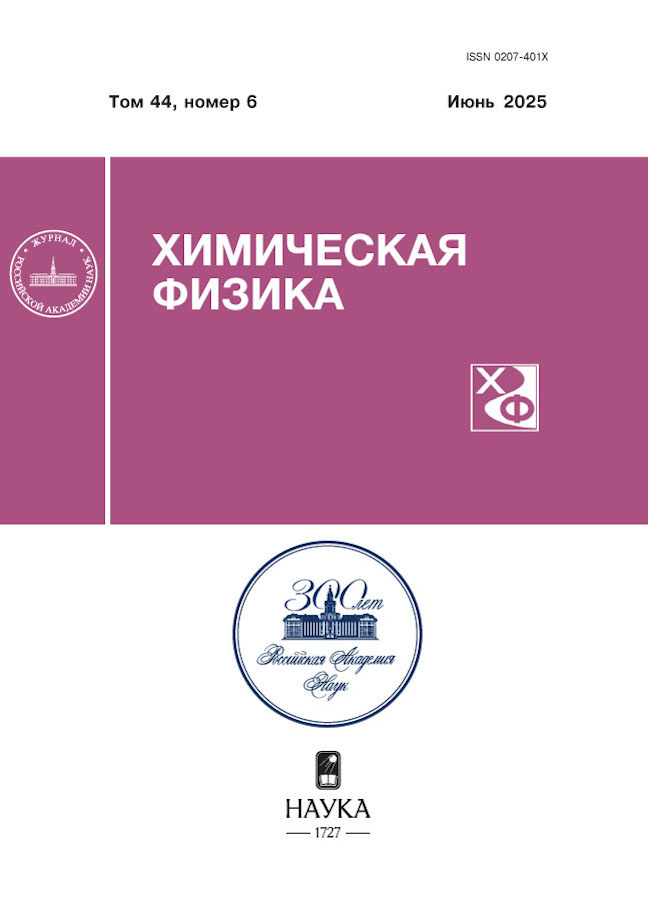Electronic Structure of Semiconductor Nanoparticles in One-Component and Mixed Systems
- Autores: Kurmangaleev K.S.1, Bodneva V.L.1, Posvyansky V.S.1, Trakhtenberg L.I.1,2
-
Afiliações:
- Semenov Federal Research Center for Chemical Physics of the Russian Academy of Sciences
- Lomonosov Moscow State University
- Edição: Volume 44, Nº 6 (2025)
- Páginas: 75-85
- Seção: Chemical physics of nanomaterials
- URL: https://kazanmedjournal.ru/0207-401X/article/view/686548
- DOI: https://doi.org/10.31857/S0207401X25060062
- ID: 686548
Citar
Texto integral
Resumo
The distribution of electron density along the radius of nanoparticles in one- and two-component semiconductor systems at different temperatures and radii of nanoparticles has been obtained taking into account physicochemical processes on their surface. The influence of surface modification of In2O3 nanoparticles by CeO2 nanoclusters in changing the distribution of conduction electrons and the magnitude of the electrostatic field in the nanoparticle volume is demonstrated. The role of these distributions in various physical and chemical phenomena involving semiconductor nanoparticles is discussed.
Palavras-chave
Texto integral
Sobre autores
K. Kurmangaleev
Semenov Federal Research Center for Chemical Physics of the Russian Academy of Sciences
Autor responsável pela correspondência
Email: litrakh@gmail.com
Rússia, Moscow
V. Bodneva
Semenov Federal Research Center for Chemical Physics of the Russian Academy of Sciences
Email: litrakh@gmail.com
Rússia, Moscow
V. Posvyansky
Semenov Federal Research Center for Chemical Physics of the Russian Academy of Sciences
Email: litrakh@gmail.com
Rússia, Moscow
L. Trakhtenberg
Semenov Federal Research Center for Chemical Physics of the Russian Academy of Sciences; Lomonosov Moscow State University
Email: litrakh@gmail.com
Rússia, Moscow; Moscow
Bibliografia
- Barsan N., Koziej D., Weimar U. // Sens. Actuators, B. 2007. V. 121. № 1. P. 18. https://doi.org/10.1016/j.snb.2006.09.047
- Wang Z., Hou C., De Q., Gu F., Han D. // ACS Sensors. 2018. V. 3. № 2. P. 468. https://doi.org/10.1021/acssensors.7b00896
- Majhi S.M., Navale S.T., Mirzaei A., Kim H.W., Kim S.S. // Inorg. Chem. Front. 2023. V. 10. № 12. P. 3428. https://doi.org/10.1039/D3QI00099K
- Suematsu K., Ma N., Yuasa M., Kida T., Shimanoe K. // RSC Advances. 2015. V. 5. № 105. P. 86347. https://doi.org/10.1039/C5RA17556A
- Yamazoe N. // Sens. Actuators, B. 1991. V. 5. P. 7. https://doi.org/10.1016/0925-4005(91)80213-4
- Lupan O., Postica V., Labat F., Ciofini I., Pauporté T., Adelung R. // Ibid. 2018. V. 254. P. 1259. https://doi.org/10.1016/j.snb.2017.07.200
- Ikim M.I., Spiridonova E.Yu., Gromov V.F., Gerasimov G.N., Trakhtenberg L.I. // Russ. J. Phys. Chem. B. 2023. V. 17. № 5. P. 774. https://doi.org/10.1134/s199079312303003x
- Ikim M.I., Spiridonova E.Yu., Gromov V.F., Gerasimov G.N., Trakhtenberg L.I. // Russ.J.Phys.Chem.B. 2024. V. 18. № 1. P. 283. https://doi.org/10.1134/S199079312401010X
- Pigalskiy K.S., Vishnev A.A., Baldin E.D., Trakhtenberg L.I. // Russ.J.Phys. Chem.B. 2024. V. 18. № 3. P. 624. https://doi.org/10.1134/S1990793124020131
- Bayan E.M., Lupeiko T.G., Knyashchuk A.A., Pustovaya L.E., Fedorenko A.G. // Russ.J.Phys.Chem.B. 2017. V. 11. № 4. P. 600. https://doi.org/10.1134/S1990793117040042
- Ikim M.I., Gerasimov G.N., Erofeeva A.R., Gromov V.F., Ilegbusi O.J., Trakhtenberg L.I. // Chem. Phys. Lett. 2024. V. 845. P. 141321. https://doi.org/10.1016/j.cplett.2024.141321
- Cabot A., Arbiol J., Morante J.R., Weimar U., Bârsan N., Göpel W. // Sens. Actuators, B. 2000. V. 70. P. 87. https://doi.org/10.1016/S0925-4005(00)00565-7
- Kurmangaleev K.S., Ikim M.I., Bodneva V.L., Posvyanskii V.S., Ilegbusi O.J., Trakhtenberg L.I. // Sens.Actuators, B. 2023. V. 396. P. 134585. https://doi.org/10.1016/j.snb.2023.134585
- Karim W., Spreafico C., Kleibert A., Gobrecht J., VandeVondele J., Ekinci Y., Van Bokhoven J.A. // Nature. 2017. V. 541. № 1. P. 68. https://doi.org/10.1038/nature20782
- Ohya Y., Yamamoto T., Ban T. // J. Am. Ceram. Soc. 2008. V. 91. № 1. P. 240. https://doi.org/10.1111/j.1551-2916.2007.02031.x
- Buckeridge J., Catlow C.R.A., Farrow M.R., Logsdail A.J., Scanlon D.O., Keal T.W., Sherwood P., Woodley S.M., Sokol A.A., Walsh A. // Phys. Rev. Mater. 2018. V. 2. № 5. P. 054604. https://doi.org/10.1103/PhysRevMaterials.2.054604
- Hagleitner D.R., Menhart M., Jacobson P. et al.// Physical Review B. 2012. V. 85. № 11. P. 115441. https://doi.org/10.1103/PhysRevB.85.115441
- Brinzari V., Cho B.K., Kamei M., Korotcenkov G. // Appl. Surf. Sci. 2015. V. 324. P. 123. https://doi.org/10.1016/j.apsusc.2014.10.072
- King P.D.C., Veal T.D., Payne D.J. et al.// Phys. Rev. Lett. 2008. V. 101. № 11. P. 116808. https://doi.org/10.1103/PhysRevLett.101.116808
- King P.D.C., Veal T.D., Fuchs F. et al. // Phys. Rev. B. 2009. V. 79. № 20. P. 205211. https://doi.org/10.1103/PhysRevB.79.205211
- Bierwagen O., Speck J.S., Nagata T. et al. // Appl. Phys. Lett. 2011. V. 98. № 17. P. 172101. https://doi.org/10.1063/1.3583446
- Kurmangaleev K.S., Mikhailova T.Yu., Polunin K.S., Ilegbusi O.J., Trakhtenberg L.I. // Chem. Phys. Lett. 2024. V. 856. P. 141649. https://doi.org/10.1016/j.cplett.2024.141649
- Prathap P., Devi G.G., Subbaiah Y.P.V., Ramakrishna Reddy K.T., Ganesan V. // Curr. Appl. Phys. 2008. V. 8. № 2. P. 120. https://doi.org/10.1016/j.cap.2007.06.001
- Jimenez B.L.C., Méndez P. H.A., Páez S. B.A., Ramírez O.M.E., Rodríguez H. // Braz. J. Phys. 2006. V. 36. № 3b. P. 1017. https://doi.org/10.1590/S0103-97332006000600058
- Belysheva T.V., Gatin A.K., Grishin M.V., Ikim M.I., Matyuk V.M., Sarvadii S.Y., Trakhtenberg L.I., Shub B.R. // Russ. J. Phys. Chem. B. 2015. V. 9. № 5. P. 733. https://doi.org/10.1134/S1990793115050048
- Landau L.D., Lifshitz E.M. Course of theoretical physics. Statistical physics. Oxford: Butterworth-Heinemann, 1980.
- Pines D. Elementary excitations in solids. New York: W.A. Benjamin, 1963.
- Gerasimov G.N., Ikim M.I., Gromov V.F. et al. // Russ. J. Phys. Chem. A. 2015. V. 89. № 6. P. 1059. https://doi.org/10.1134/S0036024415060126
- Hernández-Arteaga J.G.R., Moreno-García H., Rodríguez A.G. // Thin Solid Films. 2021. V. 724. P. 138602. https://doi.org/10.1016/j.tsf.2021.138602
- Kurmangaleev K.S., Ikim M.I., Kozhushner M.A., Trakhtenberg L.I. // Appl. Surf. Sci. 2021. V. 546. P. 149011. https://doi.org/10.1016/j.apsusc.2021.149011
- Bondarenko V.B., Kuz’min M.V., Mittsev M.A. // Physics of the Solid State. 2001. V. 43. P. 1172. https://doi.org/10.1134/1.1378162
- Novozhilov V.B., Bodneva V.L., Kurmangaleev K.S., Lidskii B.V., Posvyanskii V.S., Trakhtenberg L.I. // Mathematics. 2023. V. 11. № 9. P. 2214. https://doi.org/10.3390/math11092214
Arquivos suplementares















